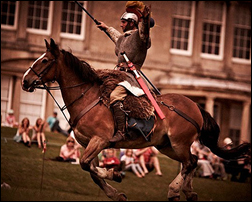
Horse archery at Sledmere House.

Mark coping with yet another saddle and uniform.

Comitatus in formation at Maryport, the ditch and rampart of the cavalry fort visible in the background.

An entertaining jump jockey!


comitatus.net/fabricasaddles.html

A German made pad saddle re-enforced with steel cantles.

Lettering is visible on the copper alloy horn stiffeners.

This Orlat plaque shows the strung bow case with attached quivers.

The combined bow case and quiver, relatively heavy equipment.
